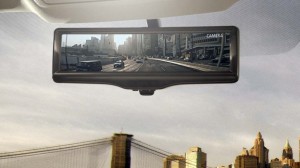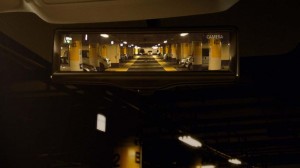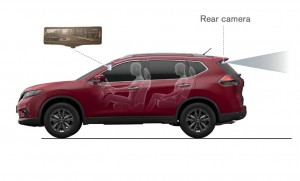
The Nissan Smart Rearview Mirror's image is virtually identical to a conventional mirror - but it eliminates obstacles inside the car.
At first glance, it looks like any ordinary Nissan Rogue, but slipping behind the wheel you might notice that the mirror is just a little bit larger, with an oversized black frame that looks a bit like nerdy tortoiseshell glasses.
And despite how you might try to adjust the rearview mirror, the image stays exactly the same – until you flip a small hidden switch. That, it turns out, shuts off the camera mounted near the top of the Rogue’s back window.
The compact crossover, it turns out, is fitted with a prototype version of Nissan’s so-called Smart Rearview mirror. Set to go on sale in Japan in 2015, it gives the driver the choice of using it as a conventional mirror or, with the flip of a switch, it becomes a video monitor connected to that little camera. That approach has a number of advantages, according to the Japanese maker. Among other things, the driver’s line of sight is no longer obstructed by backseat occupants, cargo or a narrow rear window.
Nissan isn’t the only maker toying with high-tech ways to replace conventional mirrors. Honda’s Accord sedan can be ordered with a video blind-spot monitor. And Tesla hopes to replace conventional, outside mirrors with video cameras when it launches its next product, the battery-powered Model X sport-utility vehicle.
In fact, some industry experts believe that conventional mirrors might vanish entirely in the next few decades, replaced by video screens and backed up by radar, sonar and laser warning systems. The push to replace silvered glass with more sophisticated technologies still faces the challenge of winning acceptance by federal regulators. But momentum is clearly shifting, the National Highway Traffic Safety Administration recently announcing new requirements for all vehicles to be equipped with back-up cameras, starting with the 2018 model-year.
(“Defect,” “death-trap” and “powder keg” among 69 words and phrases banned by GM. Click Here for the story.)
Nissan will introduce the optional Smart Rearview Mirror in Japan for the 2015 model-year and has plans to launch it in the U.S. within the following couple years.
While a few details – notably the design of the prototype’s thick frame – will be tweaked for the production version, the Smart mirror is already at the point where most drivers likely wouldn’t notice the difference, at least until they tried to adjust the image. A menu and buttons alter the contrast and tilt the camera. The most immediate difference, when shifting between conventional, reflective and camera modes is that any obstacles inside the car vanish.
“The real opportunity” for the system, suggested Nissan spokesman Steve Diehlman, “will be in sports cars like the Nissan 370Z, where you have just a slit of a rear window,” or in Nissan’s small commercial van, the NV, where there’s no rear window at all.
(Nissan Concept 2020 Vision offers a hint of maker’s next GT-R supercar. Click Here for a closer look.)
Unlike the backup cameras that are becoming increasingly common well before the NHTSA mandate goes into effect, the Nissan Smart Rearview Mirror is on all the time – unless a motorist switches to conventional mode. And the camera is mounted at about the same height and angle so the image on the screen is as similar as possible to what would be seen in a normal mirror.
In practice, there’s an ever-so-subtle difference in terms of colors and contrast, and fast moving objects, such as a car crossing behind in a perpendicular direction, smear slightly. But after about 15 minutes the video mirror becomes as familiar as a regular mirror – and more effective if there’s a bunch of cargo in back, like the helium balloons that came with the prototype Nissan Rogue.
The little crossover is, in a sense, a mobile video studio. It also features the maker’s Around-View monitor, which offers a virtual birds-eye view of the vehicle to make it easy to see surrounding cars and curbs when parking. And there’s also a regular backup camera display on the navigation screen.
A number of other vehicles already offer their own versions of smart mirrors. The Nissan 370Z, in fact, has its backup video display pop-up on a corner of the rearview mirror. But it vanishes when the sports car is shifted into gear.
More and more of today’s vehicles use active radar, sonar and laser sensors to spot obstacles, whether while parking or driving. That includes increasingly popular Blind-Spot Monitoring, or BLIS, systems that sound a warning if you go to change lanes with another car hidden out of sight. With the launch of its all-new Accord model last year, Honda introduced an active alternative. Click your right turn signal and an image pops up on the video monitor showing what’s normally missed by the conventional outside mirror.
Tesla wants to go a step further when it launches the Model X battery-ute in 2015. The maker hopes to win federal approval to eliminate both outside mirrors and replace them with cameras and video displays. If that idea is approved, industry observers suggest, other manufacturers will likely follow.
(Tesla reveals 2015 roll-out schedule for new Model X. Click Here for details.)
The idea of using cameras rather than mirrors has been a common theme in concept cars for decades. But makers are increasingly enamored of the idea because of the aerodynamic advantages. The drag created by conventional sideview mirrors not only lowers fuel economy but increases wind noise. Some race cars have already adopted the technology because wind drag also reduces performance.
Volkswagen will use cameras, rather than mirrors, in its hypermiling XL1 when it goes on sale in Europe in 2015. Maximizing aerodynamics was critical to achieving the car’s 261 mpg fuel economy.
Nissan doesn’t believe it will need federal approval for the Smart Rearview Mirror, but switching to video cameras for outside mirrors will require rewriting current U.S. safety standards. How soon NHTSA might act is uncertain. “It takes ages,” Tesla CEO Elon Musk lamented last year. But proponents of video technology suggest that with the new backup camera rules, regulators appear to be embracing the new high-tech alternatives, and they hope to see the changes approved soon.



It’s not very often that objects within the car obstruct the rear view mirror. What happens when the electronics fails?
The good news with the Smart Rearview Mirror is that you toggle the switch and it goes back to being a conventional mirror. (It’s the switch you normally would use to toggle between day and night viewing.)
Paul E.
Then if the normal mirror is good enought, this electronic mirror is just a toy – which of course we knew to begin with.
Yes, no, maybe. Ever try to use a rearview mirror in a Nissan 370Z or a Ford Transit Connect? When I drove the prototype Juke it was (intentionally) loaded up with cargo and the mirror was largely useless. I don’t think this is a universal alternative, but in some vehicles, and in some situations, it makes sense.
Paul E.